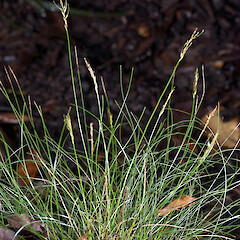Carex lectissima
Common name
fine-leaved bastard grass, hook sedge
Synonyms
Uncinia filiformis Boott; Uncinia rupestris Raoul var. rupestris Kük.
Family
Cyperaceae
Flora category
Vascular – Native
Endemic taxon
Yes
Endemic genus
No
Endemic family
No
Structural class
Sedges
NVS code
The National Vegetation Survey (NVS) Databank is a physical archive and electronic databank containing records of over 94,000 vegetation survey plots - including data from over 19,000 permanent plots. NVS maintains a standard set of species code abbreviations that correspond to standard scientific plant names from the Ngä Tipu o Aotearoa - New Zealand Plants database.
UNCFIL
Chromosome number
2n = 88
Current conservation status
The conservation status of all known New Zealand vascular plant taxa at the rank of species and below were reassessed in 2017 using the New Zealand Threat Classification System (NZTCS) – more information about this can be found on the NZTCS website. This report includes a statistical summary and brief notes on changes since 2012 and replaces all previous NZTCS lists for vascular plants.
Please note, threat classifications are often suggested by authors when publications fall between NZTCS assessment periods – an interim threat classification status has not been assessed by the NZTCS panel.
- Conservation status of New Zealand indigenous vascular plants, 2017 . 2018. Peter J. de Lange, Jeremy R. Rolfe, John W. Barkla, Shannel P. Courtney, Paul D. Champion, Leon R. Perrie, Sarah M. Beadel, Kerry A. Ford, Ilse Breitwieser, Ines Schönberger, Rowan Hindmarsh-Walls, Peter B. Heenan and Kate Ladley. Department of Conservation. Source: NZTCS and licensed by DOC for reuse under the Creative Commons Attribution 4.0 International licence.
2017 | Not Threatened
Previous conservation statuses
2012 | Not Threatened
2009 | Not Threatened
2004 | Not Threatened
Distribution
Endemic. New Zealand: North, South and Stewart Islands from Te Moehau south.
Habitat
Montane to subalpine (coastal in Fiordland). Usually in cloud forest where it grows on moss and liverwort covered ground, on peat and especially around soak holes, semi-permanent pools and on rotting logs.
Detailed description
Slender, tufted, bright green plants. Culms 30–300 mm long, < 0.5 mm wide, glabrous; basal bracts red-brown with paler striations. Leaves 4–7 per culm, < mature culms, us. < 0.5 mm wide, deeply channelled or flat with a distinct groove, bright green, glabrous at the base, scabrid towards the long-tapering, finely acute apex. Spike 5–30 × 2–3 mm, female flowers c. 10 mostly distant, internodes 2–3 mm long (up to 4 mm long at base of spike). Glumes = or < utricles, deciduous, lanceolate, acute, membranous with green midrib. Utricles 3.5–5.0 × c. 1 mm, trigonous, light greenish brown, lateral nerves prominent, somewhat spreading when ripe, stipe and beak c. 1 mm long.
Similar taxa
Carex lectissima is distinguished from all other New Zealand Carex species with hooked utricles by the light-coloured striations on the red-brown basal sheaths, and from C. obtusifolia (Heenan) K.A.Ford by the trigonous upper part of the leaf and by the acute rather than obtuse leaf apex. It could be confused with Carex minor (Kük.) K.A.Ford from which it differs by its much narrower, filiform leaves.
Flowering
October–November
Fruiting
November–March
Propagation technique
Easily grown from fresh seed and by division of established plants, though these may take a while to settle. Prefers moist soil in a a semi-shaded site. This sedge must never be allowed to dry out.
Etymology
carex: Latin name for a species of sedge, now applied to the whole group.
Where To Buy
Not Commercially Available
Attribution
Description adapted from Moore and Edgar (1970). Fact sheet prepared by Peter J. de Lange 17 August 2006.
References and further reading
Moore LB, Edgar E. 1970. Flora of New Zealand, Volume II. Indigenous Tracheophyta: Monocotyledones except Gramineae. Government Printer, Wellington, NZ. 354 p.
NZPCN Fact Sheet citation
Please cite as: de Lange, P.J. (Year at time of access): Carex lectissima Fact Sheet (content continuously updated). New Zealand Plant Conservation Network. https://www.nzpcn.org.nz/flora/species/carex-lectissima/ (Date website was queried)








